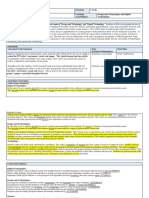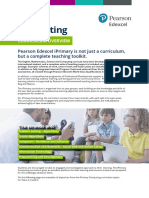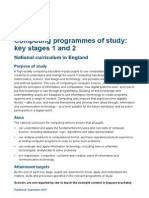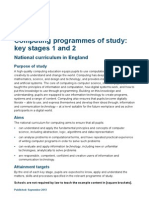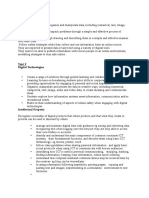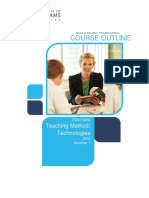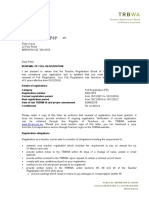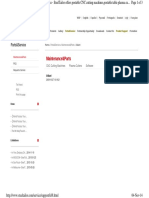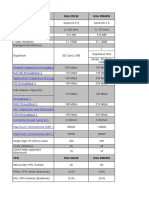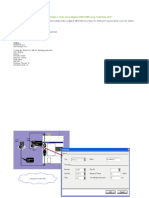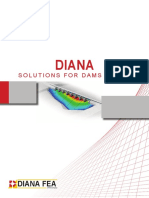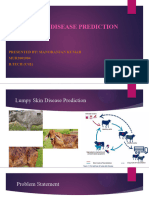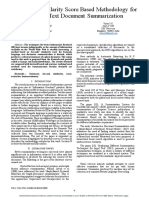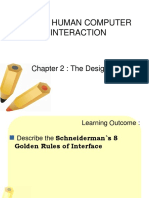DIGITAL
TECHNOLOGIES
PRE-PRIMARY
TO
YEAR
6
SCOPE
AND
SEQUENCE:
http://goo.gl/7zyngW
Lesson
Ideas:
https://goo.gl/600E6R
Strand
Understanding
and
Knowledge
understandingun
Digital
Systems
Representation
of
data
Collecting,
managing
and
analysing
data
Digital
systems
(hardware
and
software)
are
used
at
home,
in
the
school
and
in
the
community
Data
can
have
patterns
and
can
be
represente
d
as
pictures
and
Collect
and
symbols
use
data
of
any
kind
Data
can
have
patterns
and
can
be
represented
as
pictures,
symbols
and
diagrams
Technologies
Learning
Area
Scope
and
Sequence
Digital
systems
(hardware
and
software)
are
used
in
everyday
life
and
have
specific
features
Present
data
of
any
kind
using
a
variety
of
digital
tools
3
Digital
systems
(hardware
and
software)
are
used
for
an
identified
purpose
Data
can
have
patterns
and
can
be
represented
and
used
to
make
simple
conclusions
Present
data
using
a
variety
of
digital
tools
4
Digital
systems
and
peripheral
devices
are
used
for
different
purposes
Different
types
of
data
can
be
represented
in
different
ways
Collect
and
present
different
types
of
data
using
simple
software
to
create
useful
information
5
Digital
systems
and
peripheral
devices
are
used
for
different
purposes
and
can
store
and
transmit
different
types
of
data
Different
types
of
data,
and
the
same
data,
can
be
represented
in
different
ways
Collect
and
present
different
types
of
data
for
a
specific
purpose
using
software
6
Digital
systems
have
components
with
basic
functions
that
may
connect
together
to
form
networks
which
transmit
data
Data
is
represented
using
codes
Collect,
store
and
present
different
types
of
data
for
a
specific
purpose
using
software
Digital
systems
have
components
with
basic
functions
and
interactions
that
may
be
connected
together
to
form
networks
which
transmit
different
types
of
data
Whole
numbers
are
used
to
represent
data
in
a
digital
system
Collect,
sort,
interpret
and
visually
present
different
types
of
data
using
software
to
manipulate
data
for
a
range
of
purposes
�Digital
implementation
Understanding
and
Knowledge
Use
data
to
complete
a
task
Engage
with
information
known
people
have
shared
in
an
online
environmen
t,
and
model
strategies
to
stay
safe
online
Use
data
to
solve
a
simple
task/problem
Share
and
publish
information
with
known
people
in
an
online
environment,
modelling
strategies
to
stay
safe
online
Use
data
to
solve
similar
tasks/problems
Share
and
publish
information
in
a
safe
online
environment,
with
known
people
Use
visually
represented
sequenced
steps
(algorithms),
including
steps
with
decisions
made
by
the
user
(branching)
Work
with
others
to
create
and
communicate
ideas
and
information
safely
Use
simple
visual
programming
environments
that
include
a
sequence
of
steps
(algorithm)
involving
decisions
made
by
the
user
(branching)
Work
with
others
to
create
and
communicate
ideas
and
information
safely,
using
agreed
protocols
(netiquette)
Design
solutions
to
a
user
interface
for
a
digital
system
Design,
follow
and
represent
diagrammatically,
a
simple
sequence
of
steps
(algorithm),
involving
branching
(decisions)
and
iteration
(repetition)
Implement
and
use
simple
programming
environments
that
include
branching
(decisions)
and
iteration
(repetition)
Create
and
communicate
information,
including
online
collaborative
projects,
using
agreed
social,
ethical
and
technical
protocols
(codes
of
conduct)
Design,
modify,
follow
and
represent
both
diagrammatically
,
and
in
written
text,
simple
algorithms
(sequence
of
steps)
involving
branching
(decisions)
and
iteration
(repetition)
Implement
and
use
simple
visual
programming
environments
that
include
branching
(decisions),
iteration
(repetition)
and
user
input
Manage
the
creation
and
communication
of
information,
including
online
collaborative
projects,
using
agreed
social,
ethical
and
technical
protocols
Technologies
Learning
Area
Scope
and
Sequence
�Creating
solutions
by:
Investiga
Explore
ting
and
needs
for
defining
design
Explore
opportunities
for
design
Explore
design
to
meet
needs
or
opportunities
Create
a
sequence
of
steps
to
solve
a
given
task
Processes
and
Production
Skills
Define
a
sequence
of
steps
to
design
a
solution
for
a
given
task
Identify
and
choose
the
appropriate
resources
from
a
given
set
Define
a
problem,
and
set
of
sequenced
steps,
with
users
making
a
decision
to
create
a
solution
for
a
given
task
Identify
available
resources
Develop
and
communicate
alternative
solutions
and
follow
design
ideas,
using
annotated
diagrams,
storyboards
and
appropriate
technical
terms
Design,
modify,
follow
and
represent
both
diagrammatically,
and
in
written
text,
alternative
solutions
using
a
range
of
techniques,
appropriate
technical
terms
and
technology
Define
a
problem,
and
a
set
of
sequenced
steps,
with
users
making
decisions
to
create
a
solution
for
a
given
task
Identify
available
resources
Designing
Generate
and
record
design
ideas
through
describing,
drawing,
modelling
and/or
a
sequence
of
written
or
spoken
steps
Develop
and
communicate
design
ideas
through
describing,
drawing,
modelling
and/or
a
sequence
of
written
or
spoken
steps
Develop,
communicate
and
discuss
design
ideas
through
describing,
drawing,
modelling
and/or
a
sequence
of
steps
Develop
and
communicate
ideas
using
labelled
drawings
and
appropriate
technical
terms
Develop
and
communicate
design
ideas
and
decisions
using
annotated
drawings
and
appropriate
technical
terms
Producing
and
implemen
ting
Use
given
components
and
equipment
to
safely
make
simple
solutions
Use
given
components
and
equipment
to
safely
make
solutions
Use
components
and
given
equipment
to
safely
make
solutions
Select,
and
apply
safe,
procedures
when
using
components
and
equipment
to
make
solutions
Select
and
apply
safe,
procedures
when
using
a
variety
of
components
and
equipment
to
make
solutions
Use
personal
preferences
to
evaluate
the
success
of
simple
solutions
Use
personal
preferences
to
evaluate
the
success
of
design
processes
Use
simple
criteria
to
evaluate
the
success
of
design
processes
and
solutions
Select,
and
safely
use,
appropriate
components
and
equipment
to
make
solutions
Use
criteria
to
evaluate
and
justify
simple
design
processes
and
solutions
Evaluating
Select,
and
safely
use,
appropriate
components
with
given
equipment
to
make
a
solution
Use
criteria
to
evaluate
design
processes
and
solutions
developed
Develop
negotiated
criteria
to
evaluate
and
justify
design
processes
and
solutions
Develop
collaborative
criteria
to
evaluate
and
justify
design
processes
and
solutions
P
r
o
c
Technologies
Learning
Area
Scope
and
Sequence
e
s
�Collaborat
ing
and
managing
Works
with
others,
or
independently,
when
creating
designs
Technologies
Learning
Area
Scope
and
Sequence
Works
with
others,
or
independently,
to
safely
create
and
share
a
sequence
of
steps
for
making
a
solution
Work
collaboratively
to
safely
create
and
share
a
procedure
for
a
solution
Work
collaboratively
to
safely
plan
and
publish
steps
in
a
process
Work
collaboratively
to
safely
plan
and
publish
a
sequence
of
steps
Work
collaboratively
to
safely
develop
and
publish
basic
plans,
including
sequencing
of
steps
Work
collaboratively
considering
resources
and
safety,
to
plan,
publish
and
manage
projects,
including
sequenced
steps
�DIGITAL
TECHNOLOGIES
YEAR
7
TO
YEAR
10
SCOPE
AND
SEQUENCE
Strand
Digital
Systems
10
Methods
of
data
transmission
and
security
in
wired,
wireless
and
mobile
networks
Specifications
of
hardware
components
and
their
impact
on
network
activities
Role
of
hardware
and
software
in
managing,
controlling
and
securing
the
movement
of
data
in
a
digital
system
Role
of
hardware
and
software
in
managing,
controlling
and
securing
access
to
data,
in
networked
digital
systems
Digital
systems
represent
text,
image
and
audio
data
Binary
is
used
to
represent
data
in
digital
systems
Different
methods
of
manipulation,
storage
and
transmission
of
data
Simple
compression
of
data
and
how
content
data
is
separated
from
presentation
data
Collecting,
managing
and
analysing
data
Explore
how
to
acquire
data
from
a
range
of
digital
sources
Create
information
using
relevant
software,
and
create
data
to
model
objects
and/or
events
Evaluate
the
authenticity,
accuracy
and
timeliness
of
acquired
data
Evaluate
and
visualise
data,
using
a
range
of
software,
to
create
information,
and
use
structured
data
to
model
objects
or
events
Explore
techniques
for
acquiring,
storing
and
validating
quantitative
and
qualitative
data
Analyse
and
visualise
data
to
create
information
and
address
complex
problems
Apply
techniques
for
acquiring,
storing
and
validating
quantitative
and
qualitative
data
from
a
range
of
sources,
considering
privacy
and
security
requirements
Analyse,
visualise
and
model
processes
and
entities,
and
their
relationships,
using
structured
data
Design
the
user
experience
of
a
digital
system
Create
digital
solutions
that
include
a
user
interface
where
choices
can
be
made
Create
and
communicate
information
collaboratively
online,
taking
into
account
social
contexts
Design
the
user
experience
of
a
digital
system
Design
plans,
using
a
sequence
of
steps,
and
represent
them
diagrammatically
and
in
English,
to
solve
a
problem
and
to
predict
output
for
a
given
input
to
identify
errors
Implement
and
modify
solutions,
that
include
user
interfaces
within
a
programming
environment,
including
the
need
for
choice
of
options
and/or
repeating
options
Create
and
communicate
interactive
ideas
collaboratively
online,
taking
into
account
social
contexts
Design
the
user
experience
of
a
digital
system
Design
algorithms,
represented
diagrammatically
and
in
structured
English,
and
validate
plans
and
programs
through
tracing
Implement
and
apply
data
storage
and
organisation
techniques
Create
and
use
interactive
solutions
for
sharing
ideas
and
information
online,
taking
into
account
social
contexs
Digital
implementation
Representation
of
data
Processes
and
production
skill
Processes
and
Production
Skills
Processes
and
Production
Skills
s
Knowledge
and
understanding
8
Different
types
of
networks,
including
wired,
wireless
and
mobile
networks
Hardware
components
of
a
network
Technologies
Learning
Area
Scope
and
Sequence
Design
algorithms
represented
diagrammatically
and
in
structured
English,
including
iteration
Validate
algorithms
and
programs
using
common
acceptable
methods
Implement
data
storage
and
organisation
techniques
within
a
programming
environment
Create
interactive
solutions
for
sharing
ideas
and
information
online,
taking
into
account
social
contexts
and
legal
responsibilities
�Creating
solutions
by:
Define
and
break
down
a
Investigatin
given
task,
identifying
the
g
and
purpose
defining
Consider
components/resources
to
develop
solutions,
identifying
constraints
Designing
Processes
and
production
skills
Design,
develop,
review
and
communicate
design
ideas,
plans
and
processes
within
a
given
context,
using
a
range
of
techniques,
appropriate
technical
terms
and
technology
Follow
a
plan
designed
to
solve
a
problem,
using
a
sequence
of
steps
Investigate
a
given
need
or
opportunity
for
a
specific
purpose
Evaluate
and
apply
a
given
brief
Consider
components/resources
to
develop
solutions,
identifying
constraints
Design,
develop,
evaluate
and
communicate
alternative
solutions,
using
appropriate
technical
terms
and
technology
Produce
a
simple
plan
designed
to
solve
a
problem,
using
a
sequence
of
steps
Identify
and
define
the
needs
of
a
stakeholder,
to
create
a
brief,
for
a
solution
Investigate
a
selection
of
components/resources
to
develop
solution
ideas,
identifying
and
considering
constraints
Apply
design
thinking,
creativity
and
enterprise
skills
Design
solutions
assessing
alternative
designs
against
given
criteria,
using
appropriate
technical
terms
and
technology
Identify
the
needs
of
the
client/stakeholder
to
determine
the
basis
for
a
solution
Create
and
critique
briefs
to
solutions
Investigate
components/resources
to
develop
increasingly
sophisticated
solutions,
identifying
and
considering
associated
constraints
Apply
design
thinking,
creativity,
enterprise
skills
and
innovation
to
develop,
modify
and
communicate
design
ideas
of
increasing
sophistication
Design
possible
solutions
analysing
designs
against
criteria,
including
functionality,
accessibility,
usability
and
aesthetics
using
appropriate
technical
terms
and
technology
Producing
and
implementing
Safely
make
solutions
using
a
range
of
components,
equipment
and
techniques
Safely
apply
appropriate
techniques
to
make
solutions
using
a
range
of
components
and
equipment
Safely
select,
implement
and
test
appropriate
technologies
and
processes,
to
make
solutions
Evaluating
Independently
apply
given
contextual
criteria
to
evaluate
design
processes
and
solutions
Develop
contextual
criteria
independently
to
assess
design
processes
and
solutions
Evaluate
design
processes
and
solutions
against
student
developed
criteria
Analyse
design
processes
and
solution
against
student
developed
criteria
Collaborating
and
managing
Work
collaboratively,
and
individually,
considering
resources
and
safety;
to
plan,
publish
and
manage
projects,
including
sequenced
steps
Plan,
publish
and
manage
projects,
collaboratively
and/or
individually,
considering
safety,
specific
task
requirements,
time
and
other
required
resources
Project
planning
using
appropriate
interactive
digital
technology,
creating
an
iterative
and
collaborative
approach,
identifying
risk
and
safety
considerations
Use
appropriate
interactive
digital
technology
to
plan
and
manage
projects,
using
an
iterative
and
collaborative
approach;
identifying
risks
and
analysing
time,
cost,
production
processes,
safety,
sustainability
and
legal
responsibilities
Technologies
Learning
Area
Scope
and
Sequence
Safely
select,
justify,
implement
and
test
appropriate
technologies
and
processes,
to
make
solutions
Technologies
Learning
Area
Scope
and
Sequence









